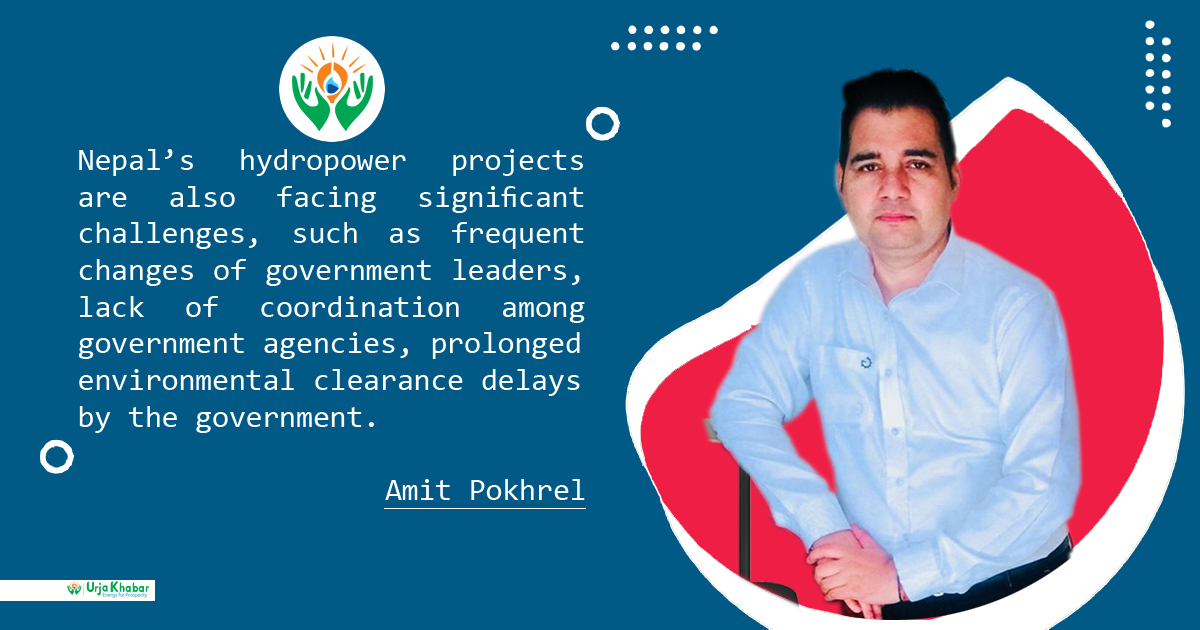Energy Update
Energy Consumption for Economic Development in Cooperation in South Asia

Nepal is striving to make the most of its abundant energy resources by capitalizing on the progress made in addressing the energy crisis experienced. In the past, Nepal has faced a period of power shortage, which has hindered the progress of development. The government is now concentrating its efforts on the development and expansion of hydropower and all forms of renewable energy sources to ensure the provision of clean electricity and a secure supply of electricity to the people of Nepal over the coming five ten years. As economic growth accelerates, energy consumption increases, leading to an increase in import dependency. The inefficient use of energy in support of economic growth further increases the rate of energy consumption with the resulting environmental degradation. This will contribute to energy conservation, which is an essential part of the energy supply.
To minimize the losses of this precious commodity, an entire supply chain approach was adopted, from the source to the end-user level. It is essential to introduce as many indigenous energy sources as possible to reduce the load of fossil energy imports and the generation of employment. Furthermore, the alternative sources of energy are more environmentally friendly. Nepal has abundant water resources, which can be utilized for the development of hydropower, including through FDI and cross-border trade. Mutual experiences can be used to shape and/or improve their respective policy / legislative environment.

The Government has set a goal to raise per capita electricity use to 1500 kWh within the next decade by revamping consumption and distribution methods to reduce the reliance on fossil fuels. To meet these objectives, the Government intends to generate hydroelectricity of 3000 MW, 5000 MW and 10000 MW, respectively, from the economically viable amount within the next three, five and ten years, by leveraging public and private investments in small-medium- and large-scale projects.
Nepal has made significant progress in cooperation with neighboring countries. The South East Asia Association for Regional Cooperation Framework Agreement on Electricity Cooperation (SAARC) entered into force in November 2014, which opened the door for relevant institutions in the countries concerned to establish transmission interconnectivity in the region to facilitate cross-border energy supply. In the year 2022, Nepal and India concluded a Power Trade Agreement, paving the way for free trade in power. In the year 2018, Nepal signed a MoU for establishing a Mechanism for Energy Cooperation between Nepal and China, reinforcing its commitment to strengthen cooperation and opening up an avenue for cooperation in the sector. In August 2018, Nepal signed a MoU for Cooperation in the Energy sector with Bangladesh, allowing the export of surplus electricity to the country.

In May 2018, the Ministry of Water, Power and Irrigation issued a white paper to achieve self-sustainable electricity through the overall development of the electricity sector, reduce the trade deficit by replacing other sources of electricity with electricity, expanding internal and external markets of electricity, and providing sustainable, reliable, and clean electricity to the people. In the white paper, the government outlined its plan to amend the Electricity Act, and Nepal Electricity Authority Act, and formulate the renewable energy development law. The government plans to set up the Electricity Regulation Commission within the framework of the Electricity Regulation Commission Act 2017. The white paper includes a ‘one province, one mega project’ strategy to construct mega hydro or solar projects in each of the 7 provinces.
Nepal seeks to foster a constructive and accountable international relationship that adheres to a variety of bilateral, regional and multilateral arrangements. It is committed to cultivating amicable and cooperative commercial relations with its major trading partners, namely India and China. The two countries have open borders and a multifaceted and mutually beneficial relationship in economic terms, with the primary focus on trade and transit. India not only accounts for a significant portion of Nepal's total trade but also accounts for nearly 57% of the country's total exports (NRB).
Nepal has experienced a surge in bilateral trade with Bangladesh since the opening of the transit route between the two countries. Over the years, Bangladesh has become an increasingly important trading partner for Nepal. Despite the Government's sincere efforts, Nepal still faces several obstacles to economic growth. The most significant of these is the country's geographical location, which increases the costs of infrastructure development, production, and business operations. Additionally, supply-side capacity limitations, a trade deficit, and a lack of diversification of trade remain major challenges.
Nepal is heavily reliant on India and China for its trade, and the trade deficit with these two countries has increased. Furthermore, the country's trade performance has been hindered by a lack of economic, social and commercial infrastructure. Issues such as road infrastructure, training, education and certification have been a major challenge. The government has made significant progress in reforming the trade and investment system, which has enabled Nepal to become a more integrated part of the global economy, providing more growth and investment opportunities. Legal reforms, particularly in the trade and investment area, must be accelerated to reduce the risks of an alarming trade deficit. The government is taking steps to improve exports by increasing supply-side capacity and managing imports.
In addition, Nepal is endowed with a wealth of potential in the energy sector, particularly in the hydropower sector, as well as in the areas of infrastructure development. The Government is strongly committed to achieving double-digit growth, which necessitates an increase in investments in large-scale infrastructure and project development. Plans include the development of transport infrastructure, such as railways, waterways and airports, as well as expressways and tunnelways, cable cars, and energy infrastructure. This includes mega-hydropower projects and transmission lines, as well as the expansion, reinforcement, and modernization of the distribution system.
Reforms in the financial sector, such as the establishment of infrastructure development banks in partnership with the private sector, and the introduction of new financial services, such as mixed financing, private capital, venture funds, hedge funds, and credit ratings, are expected to contribute to the development of hydropower and infrastructure. To take advantage of the opportunities available, various policy reforms, such as the implementation of the Public-Private Partnership (PPP) Act, the improvement of mega-project management, coordination between government agencies and stakeholders, and the involvement and support of the people are all essential.
Nepal's economic diplomacy has enabled the country to develop and strengthen its bilateral, regional and multilateral relations, providing the country with a wealth of opportunities. Significant agreements have been signed with its neighbouring countries to facilitate trade and transit connectivity, as well as to facilitate investment. Sub-regional connectivity has been further enhanced through the signing of the BBIN Multilateral Agreement with Bangladesh and Bhutan. These initiatives provide access to the vast market of neighbouring countries and regional and global markets, while significant steps have been taken towards increased energy cooperation. Nepal has signed Partnership and Trade Agreements (PTA) with its neighbouring countries, as well as the SAARC Framework Agreement (FA) on Energy Cooperation at the regional level. Nepal must focus on speeding up the implementation of the various bilateral agreements. Additionally, Nepal must take a leadership role in achieving the aspirations for greater regional connectivity and collaboration through the successful implementation of regional agreements.
It is clear that the need for increased energy investment is pressing and the rationale for harnessing hydropower is clear, however, investments in the development of hydropower are subject to a variety of potential risks, particularly in mountainous areas such as the Himalayas, which are associated with climate variability, sedimentation, lack of reliable data, and other environmental, economic, and financial hazards. Nevertheless, this does not necessarily mean that the investment itself poses a risk; in fact, the risks associated with hydropower development are likely to be relatively low and manageable.
Hydropower assets' performance is highly contingent upon environmental variables (e.g., river flows, water management regulations, downstream and upstream water use, etc.). Our basin-level approach thus utilizes an integrated approach to water resource management. The generation of hydropower is closely associated with the availability of river water resources, which can vary both seasonally and annually.
The development of hydropower in South Asia is highly complex due to the natural environment and the associated risks associated with climate change. Projects such as these are subject to a variety of risks, such as climate change, sediment loads, and other environmental, social, and financial risks. It is essential to address these risks to generate promising investments that will perform optimally over their design lifecycles and generate the anticipated benefits. Despite the existence of risks, this does not necessarily mean that the project is inherently risky. However, it does suggest the need for a systematic risk assessment process. IDA 17 necessitates a thorough assessment of hazards, including those related to climate change, in all projects.
In the long term, the expansion of hydropower generation has the potential to generate higher domestic incomes, reduce real domestic energy costs, alleviate poverty, and provide insurance against oil price fluctuations. Furthermore, this study demonstrates that Nepal has the potential to provide environmental services to South Asia by providing clean, renewable energy and mitigating climate change.
The Author of this article works as a Senior Contract Project Expert in the Energy Business of Golyan Group, Kathmandu, Nepal
Reference
1. Energy consumption of the countries in the context of economic development and energy transition - ScienceDirect
2. Economic development and energy consumption in the GCC: an international sectoral analysis | Energy Transitions (springer.com)
3. Chapter 11 - Energy and Economic Prosperity (undp.org)
4. Energy consumption and economic growth in Indonesia (zbw.eu)
5. Hydropower Development and Economic Growth in Nepal (South Asia Working Paper No. 70) (adb.org)
Conversation
- Info. Dept. Reg. No. : 254/073/74
- Telephone : +977-1-5321303
- Email : [email protected]














